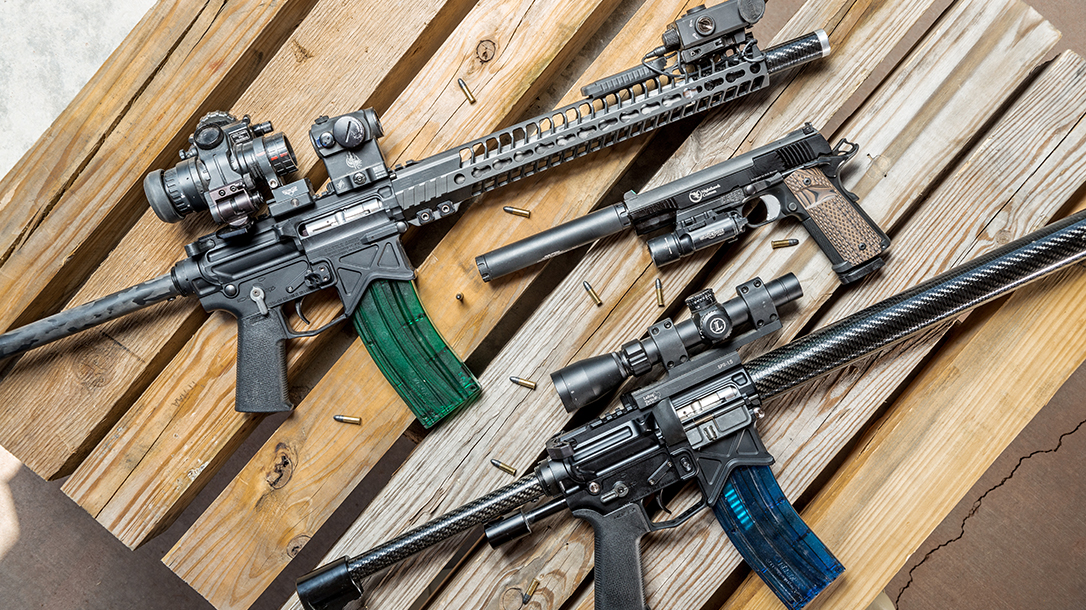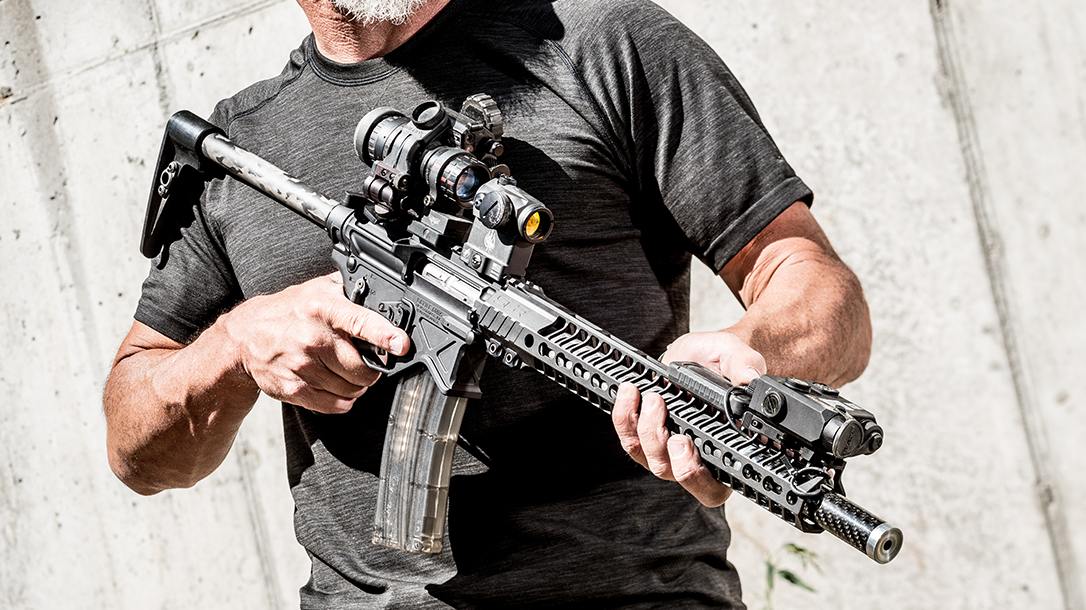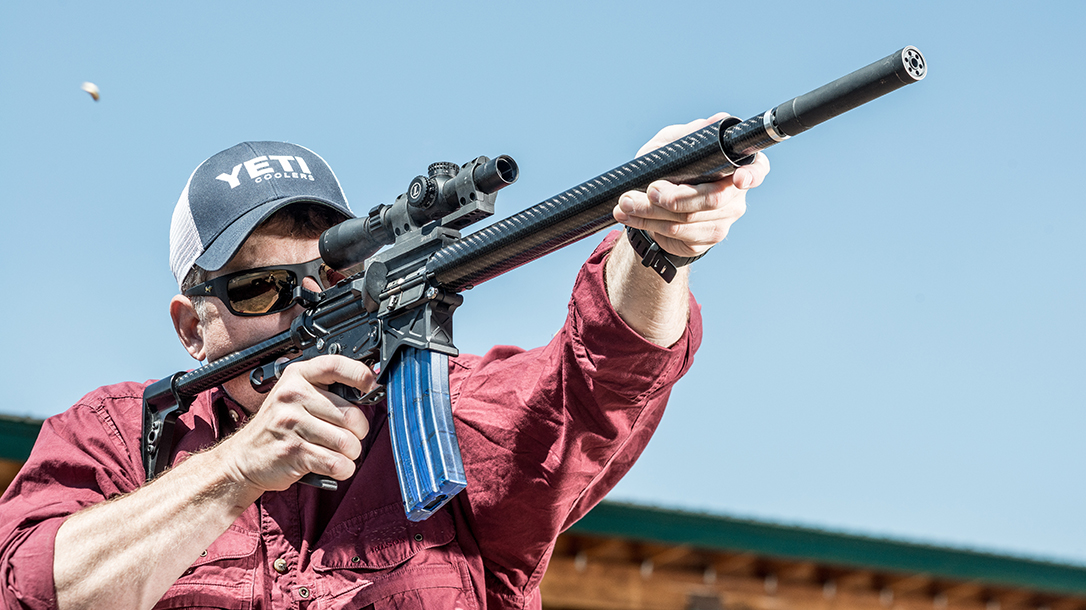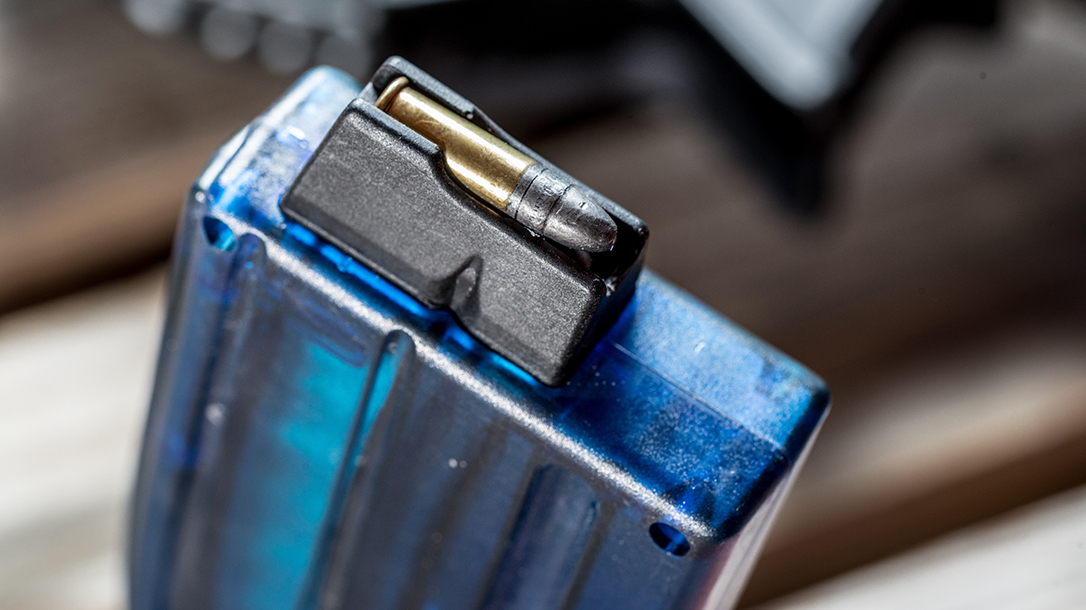Talk to any game warden about rifle ballistics looking for a tip on the best deer cartridge, and they’ll likely laugh in your face, then tell you more deer have been killed by the .22 LR than any other round. Setting aside for a moment the ethical issue that those deer mostly fell to poachers, the choice and frequency of the smaller and quieter yet effective cartridge speaks volumes. Though not a long-range round or the first pick for shooting through an engine block, the .22 LR cartridge is a reliable, lethal and inexpensive alternative for the defensive shooter, and it suppresses like a dream.
.22 LR Economics
Consider first the economics of the cartridge both in financial and gravitational terms. The average cost of a .22 LR round is about $0.06. Compared to a .223 at $0.45 and a .308 at $0.80, the .22 LR is a steal. Ask yourself, is your AR seven times better, or your .30-caliber bolt gun 13 times better, than your .22 LR? As for weight, 50 rounds of .22 LR ammo weighs 8 ounces. The same .223 round count weighs 1.5 pounds while that many .308s weighs a whopping 3 pounds. So, by way of general comparison, 5 pounds of ammo would get you 500 rounds of .22 LR, 165 rounds of .223 Remington or 83 rounds of .308 Winchester.
Advertisement — Continue Reading Below
Admittedly, this isn’t an apples-to-apples comparison. A pocketknife isn’t a sword, and there are certainly shooting tasks for which the .22 LR’s ballistics are insufficient. But are you spending and carrying more than you need given the likelihood of the outcomes for which you are preparing? If your training budget is tight, how long would it take a rimfire AR to pay for itself simply in ammo savings? These are good questions and exercises to examine for yourself and your personal defense or survival situation.
Small-Bore Sentinels With Chris Costa
If your curiosity is piqued and your brain is working, but your first thought is of that bolt-action, single-shot .22 LR that you learned to shoot with, I have good news for you: Much has changed recently in the world of rimfire firearm design. One shooter that has tracked and in some respects driven this trend is Chris Costa.
Costa is well known in the shooting industry, beginning with a large splash onto the scene with the first training videos from Magpul Dynamics. Now the CEO of Costa Ludus, he trains students across the U.S. and in his home state of Wyoming. When not on the square range, Costa has focused a significant amount of his time on blending the techniques and technologies of the tactical world into survival applications. Night vision, stealth and minimalist influences have found their way into his choices for what he packs, carries and stages in the event of a natural disaster or societal emergency.
Advertisement — Continue Reading Below
Costa modeled his AR-style rimfires after his traditional centerfire ARs and reached out to Jimmy Hendrix to help build them. Hendrix, a former bodyguard for Steven Seagal, also crafts custom ARs with an eye for reducing weight without sacrificing durability. Costa runs two unique rimfire ARs built by Hendrix on Battle Arms Development (BAD) platforms.
Costa’s Aimpoint AR Setup
The first is a short-range, night-vision-capable SBR set up with an Aimpoint Micro T-1 red-dot sight and a detachable PVS-14 on a Wilcox mount. This platform also in includes an SLR Rifleworks rail with a Steiner DBAL laser-aiming device at the muzzle. He runs see-through polycarbonate AR15.22 Sonic Weld magazines from Black Dog Machine that hold 25 rounds and have followers that lock the bolt open after firing the last round. They’re available in a variety of colors that Costa uses to code the magazine to the ammunition type it contains for easy reference.
The BAD AR’s controls are identical to a centerfire AR’s. Out of personal preference, Costa added a Geissle trigger and a Magpul MOE grip. The stock is an ultralight, fixed, carbon-fiber model custom-built by Hendrix with a QD sling mount in the buttplate. As the .22 LR action does not require a buffer spring, the stock can be much smaller and lighter. Finally, the 11.5-inch, carbon-fiber-wrapped Taccom barrel sports a 3-inch carbon-fiber suppressor also custom-made by Hendrix. Costa has both of his rimfire ARs set up to run either a twist-off muzzle brake or suppressor.
Advertisement — Continue Reading Below
The concept behind this rifle is similar to a CQB AR. “I can run and gun with this rifle. It’s compatible with a PVS-14 with an IR laser, or an active laser and dual-tube night-vision devices,” Costa said. “This isn’t the type of rifle you’d use to engage targets with body armor or vehicles. Rather, it’s designed for subsonic ammo and precise shots at exposed areas on threats within 50 yards.”
Costa’s Leupold AR Setup
His second rimfire AR is a medium-range setup built around a Leupold 1-4x20mm VX-2 scope with custom subsonic turrets. Mounted on a LaRue Tactical SPR 1.5 mount, the VX-2 has elevation markers for precise shots in 50-yard increments out to 200 yards. For a subsonic .22 LR, the longer end of the 200-yard range can mean significant elevation adjustments, but the added magnification puts a subsonic 40-grain CCI bullet within a mil-spec 4 MOA at 200 yards.
Advertisement — Continue Reading Below
One clever feature with this AR is a threaded post below the carbon-fiber stock. In real estate ordinarily occupied by a buffer spring and stock body, Costa can store either the screw-on muzzle brake or his AAC Prodigy suppressor; this way the suppressor is always attached to the weapon. The rifle’s 17-inch, carbon-fiber-wrapped barrel, also made by Taccom, is shrouded by a custom carbon-fiber handguard. It’s purpose-built to be smooth and as light as possible.
“I like this setup for targets and small game outside red-dot range. My rimfire rigs are intended both for personal defense and survival. With this rifle suppressed, I can take small game without the fear of the report scattering every other possible food source in the area,” Costa said.
Chris Costa and His Nighthawk Rimfire
But as an instructor, rimfire ARs are also a milder introduction to firearms for new shooters. “I have had multiple situations where non-shooters who were scared by the recoil of larger guns started on the AR .22s and then confidently moved up to a 5.56mm after learning the controls.
Advertisement — Continue Reading Below
There have also been cases when I have had students with an injury that ran the .22s in lieu of the 5.56mm. The controls are the same, but the weight savings is around 4 pounds. On ranges within 50 yards on steel or paper, the training value is the same without the strain of the heavier ammunition. Over three days, the extra weight can take its toll on someone with a bad joint or back.”
For a rimfire handgun, Costa chose a Nighthawk with a Bob Marvel conversion kit. A longtime user of Nighthawk 1911s, the feel and controls are familiar and reliable. The AAC Prodigy suppressor is also interchangeable between the rifles and pistol, and Costa prefers Elliason green fiber-optic sights. Outfitted with VZ G10 grips and a SureFire light, the rimfire conversion is hard to distinguish from a .45 ACP version.
Ruger Upgrades
But what if your budget and interests don’t extend to a tactical conversion exercise and all this talk leaves you asking why you would replace that old faithful Ruger 10/22 in your gun safe? The good news is, you aren’t alone, and the better news is that you have options—lots of them. Ruger has built more than 5 million 10/22s since they were introduced in 1964, and many shooters today started with these semi-autos. I remember my first one, and I still own it.
Advertisement — Continue Reading Below
Tactical Solutions of Boise, Idaho, has earned a good reputation by creating enhanced parts and options for the Ruger 10/22, as well as adaptations to other third-party stocks and accessories. I own both a Ruger 10/22 Takedown rifle and a 22/45 pistol. So I decided to sacrifice them both to the gods of experimentation. Tactical Solutions makes enhancements for both, and I was curious to see what the company’s additions would net both platforms in functionality and performance.
My Upgraded Rifle
For the 10/22 Takedown rifle, I switched out the standard wood stock for Magpul’s X-22 Backpacker. This aftermarket stock is wildly popular for its sheer ingenuity and affordability. While similar in profile to the standard Ruger 10/22 Takedown stock, the X-22 reduces weight, adds storage space for ammo and survival tools, and replaces wood with weatherproof polymer. Like the full-sized Hunter X-22, the Backpacker version also features multiple QD mounts for a sling, a locking interface to attach the barrel assembly to the receiver, and a rubber buttpad.
I also replaced the barrel with one of Tactical Solutions’ shorter but stiffer matte black X-Ring Takedown bull barrels. The X-Ring barrel is 2 inches shorter and comes with adjustable fiber-optic sights and 1/2×28 threads for a suppressor. I also opted to mount an Aimpoint Micro T-1 on the barrel so it maintains its zero when the rifle is assembled. As a final touch, I added a Tactical Solutions extended magazine release; it allows you to release the magazine with your strong hand while still in a firing position. I also stuffed a small Swiss Army knife, a spare CR2032 battery for the Aimpoint sight and some matches in the grommeted handguard storage space.
Advertisement — Continue Reading Below
So what did all this added attention to my dusty rimfire net me? The updated rifle can now be suppressed and shoots 0.5-inch groups at 25 yards. I can also carry up to 30 additional rounds in loaded magazines inside the buttstock’s storage space. It’s truly a grab-and-go survival rifle that would make for a vital tool in a situation where personal defense and small-game foraging are the primary concerns. Also, Tactical Solutions’ Ascent22 suppressor fits both the rifle and 22/45 and is easily interchangeable.
The Enhanced 22/45
Like the 10/22, Tactical Solutions produces a line of barrels for Ruger’s Mark series pistols. I replaced the standard barrel on my 22/45 with the threaded, 4.5-inch Pac-Lite and added a Trijicon RMR directly to the top rail. I also added Tactical Solutions G10 grip panels and a Ruger Racker to the bolt. Like the magazine release on the original 10/22, the bolts on Mark series pistols are finger pinchers. Meanwhile, the polymer Racker allows for quicker and easier charging.
These small changes transformed the 22/45 from a solid, basic rimfire to a fast-handling, suppressor-capable system with both iron and red-dot sights. Though the magazines are single-stack and limited to 10 rounds, the 22/45 now performs like an enhanced competition pistol. From 30 feet, it printed 1-inch groups with the Trijicon RMR. With the Ascent22 suppressor attached, it only weighs 1.8 pounds, making it easy add to a day pack for a trip into the woods.
Advertisement — Continue Reading Below
So are rimfires the answer to Third World debt and global warming? No. But they are simple, efficient and in many cases a better alternative to larger, heavier and more expensive centerfire weapons. With modern functional updates, your old faithful .22 LR may return to a rightful place in your plan and rotation. And at the end of the day, what’s more fun than a .22?
For more from Chris Costa, please visit CostaLudus.com.




























